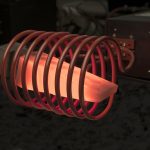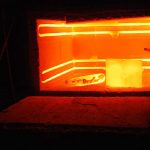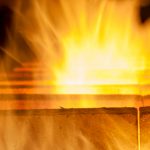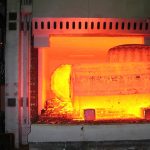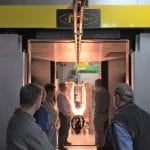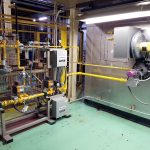Q&A with Trevor Jones
As a quick refresher, remind our readers of Solar Manufacturing’s role in the heat-treat industry?
Solar Manufacturing is a premier vacuum furnace manufacturer that specializes...
Ambrell has been all about induction heating since 1986
Established in 1986, the Rochester, New York-based IHEA member manufactures a range of induction heating solutions. The company has steadily grown from a small...
90-plus authors submit abstracts for European heat treat conference
So far, more than 90 authors from 22 countries have provided abstracts to the 27th IFHTSE Congress and ECHT2022. The contributions cover a wide...
Some workpieces are too large and expensive to fit into conventional benchtop hardness testers
Portable Rockwell Hardness Testing of Large Induction Hardened Work Pieces
The previous article identified many factors related to benchtop Rockwell hardness testing practices. This article...
Understanding the Jominy end quench test
The Jominy end quench test (ASTM A255 ) is an extremely simple and useful test that is applicable to many materials besides steel...
Fundamentals of Industrial Process Heating – learn online with IHEA
IHEA’s Fundamentals of Industrial Process Heating Online Learning Course has been a successful source of high-level learning to those in the industrial heat processing...
Transitions and transformations in the workplace
In the heat-treat world, metals are carefully ramped up to certain temperatures to allow for transformation of the microstructure. Temperature and time allow the...
Q&A with Eric Ford
What does Graphite Metallizing Corporation do for the heat-treat industry?
Graphite Metallizing Corporation makes a product called Graphalloy. It’s basically a graphite/metal alloy, that we...
Getting Control — Let’s Start with PID
It does not matter what thermal treatment work piece requires, proper control is the foundation for repeatability and quality processing. For heat-treating processes, there...
Conference updates and other IFHTSE highlights
ECHT 2023 Conference
AIM is proud to announce the ECHT 2023 Conference in Genova, Italy, at Magazzini del Cotone. The conference will meet May...
Case Depth Determination
Methodology to ensure design intent is satisfied
Q&A with Bill St. Thomas
Please tell us a little about your background.
I started in the heat treating industry back in the late 1960s working for one of my...
AMS2750 pyrometry revisions tweak a crucial process
AMS2750 pyrometry is a daunting heat-treat special process requirement in the aerospace industry. It’s a literal definition implying measurement of temperature, but it also...
IHEA’s Fundamentals of Industrial Process Heating starts October 24
IHEA’s Fundamentals of Industrial Process Heating Online Learning Course has been a successful source of high-level learning for those in the industrial heat-processing industry...
Influence of agitation on polymer quenchants
Polymer quenchants are used extensively to quench a large variety of materials in a variety of processes. Polymer quenchants can be used for immersion...
Q&A with Tim Donofrio
Can-Eng Furnaces was recently awarded two contracts for its high-capacity line of mesh belt fastener heat treatment systems. What made this system ideal for...
Predicting strains key to evaluating heat-treat response
Quench hardening of steel components requires the components to be heated to a temperature such that the solid-state crystal structure of the material changes...
Q&A with Lauren Jones
Why is it important to invest in the future of heat-treating?
Nearly every metal component undergoes some type of heat-treating application. Vacuum furnaces contribute to...
Finding data needed for modeling and simulation
Modeling and simulation have become an important part of the design and manufacturing toolbox. Modeling and simulation are used in forging, casting, machining, forming,...
Understanding gas composition
Evaluating furnace atmospheres for proper gas composition is the key to desired performance results
Atmosphere furnace control
Proper temperature is crucial to part quality, but don’t overlook its effect on atmosphere control
Heat treatment process modeling development for age-hardenable alloys
Age-hardenable alloys, such as some aluminum alloys, maraging steel, and nickel-based alloys, get their strength not from quenching but from the precipitation that occurs...
Heat treating from the operator’s perspective
Often, a customer visit involves a walk through the facility. Comments are made about how clean it is or how well organized a process...
Nonlinear distortion response during gas quenching
High-pressure gas quenching (HPGQ) is touted as a way to reduce distortion of difficult-to-quench geometries. Quench pressures and quench gas flow velocities are chosen...
An overview of heat treatment techniques
Editor’s note » This is the second in a five-part series.
In this second segment of my series on heat-treating techniques, I will discuss the...
Fatigue failures in nickel-based austenitic Superalloy 718
Superalloy 718 is widely used for aerospace, nuclear, power generation, metal processing, medical, material processing, and chemical and petrochemical industries due to its excellent...
Variation in steel hardenability
Many heat-treating processes cannot tolerate appreciable variations in steel hardenability. For an established in-control process, deviations in chemical composition and starting microstructure may result...
IHEA offers hands-on training with Powder Coating and Curing Processes Seminar
The Industrial Heating Equipment Association (IHEA), the Chemical Coaters Association International (CCAI), Products Finishing magazine and Southern Company have teamed up to provide a...
Deadline approaching for ECHT2022 conference abstract submissions
Abstract submission deadline is January 31, 2022, for the 27th IFHTSE Congress in Salzburg, Austria, September 5-8, 2022, at the Wyndham Grand Salzburg Conference...
Coupling Alloy and Process Selection
Combining both alloying and processing into a single strategy to achieve a desired level of performance sounds like a simple concept, but can be...
Developing a superalloy with superior heat resistance
Demand for superior machinery that can operate effectively under extreme conditions is driving the development of newer alloys. One significant example is the preparation...
Furnace Maintenance
When a heat treat manager or anyone responsible for purchasing heat treating equipment makes a buy decision, they must first consider the process required,...
Willingness to change course leads to satisfying career
Editor’s note: Beginning with the March issue of Thermal Processing, we added Tony Tenaglier, a heat treat process engineer at Hitchiner Manufacturing, as a...
Carburizing and Steel
In carburizing, gears must be heated to reach the appropriate temperature for the steel grade without causing excessive grain growth and distortion in a...
Q&A with Tom Baldock
What you do at Guill Tool?
My responsibilities here are for sales in the aerospace area. I’ve been in sales most of my adult life,...
Make plans to attend Heat Treat 2023
Heat Treat 2023 will be in Detroit, Michigan, October 17–19. This event will be co-located with IMAT 2023 and the Motion+Power Technology Expo and...
MP Combustion: Supply and support of the best combustion equipment
MP Combustion, based in Cincinnati, Ohio, is IHEA’s newest member company. MP is a regional leader in the supply and support of industrial combustion...
Member spotlight: Karl Dungs markets combustion controls
Karl Dungs, Inc, a subsidiary of Karl Dungs GmbH & Co. KG, was established in 1997 as the Dungs sales channel for the North...
Heat treatment of aluminum VI – Artificial aging
In the previous column, we described the fundamentals of natural aging. In natural aging, the solid solution obtained after quenching starts to form precipitates...
Distortion during heating
Minimizing distortion involves more than just optimizing cooling











